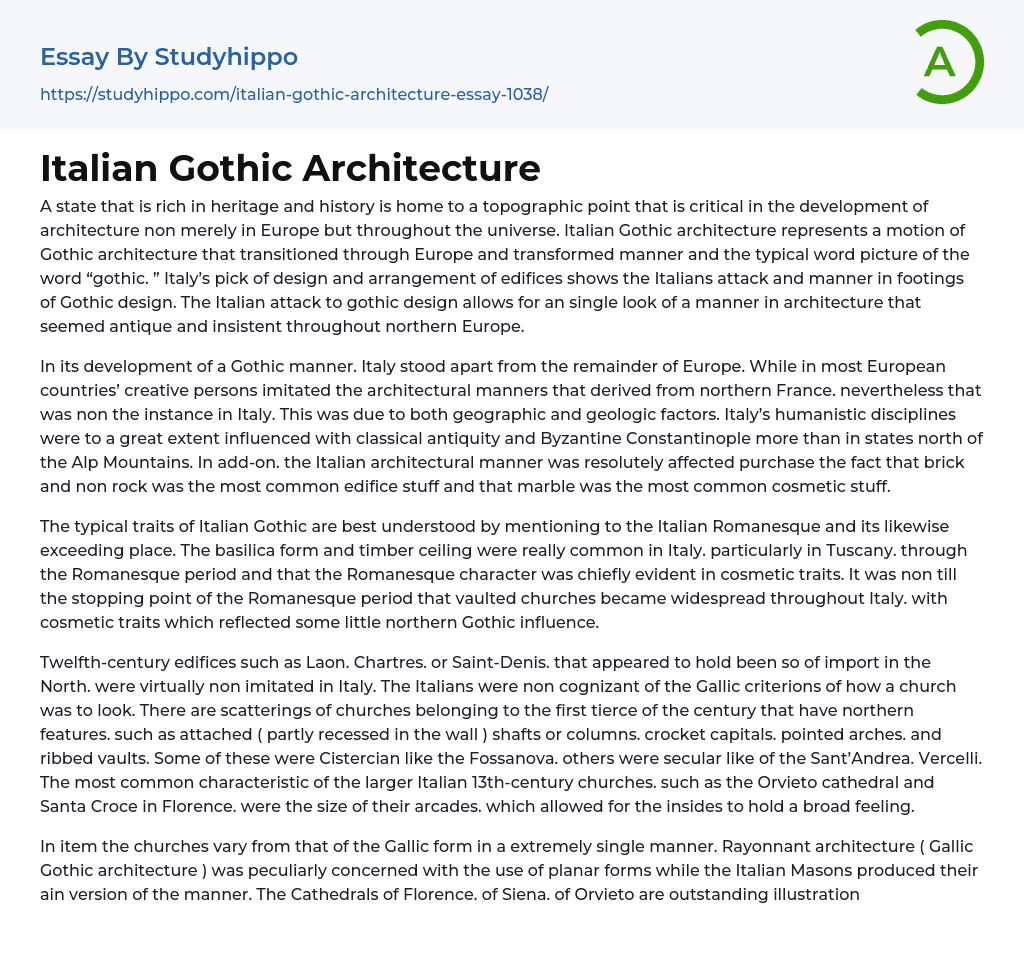Italian Gothic architecture is significant not only in Europe but globally, as it represents a crucial advancement in the field. It symbolizes a movement that spread throughout Europe, altering the perception and style of "gothic" architecture. Italy's choice of construction and arrangement of buildings showcases their unique approach and style within the realm of Gothic design.
The Gothic design in Italy created a unique and antique style in architecture that spread throughout northern Europe. Unlike other European countries, Italy developed its own Gothic style instead of imitating the architectural trends from northern France. This distinction can be attributed to geographical and geological factors.
Italy's humanistic disciplines were greatly influenced by classical antiquity and Byzantine Constantinople more than states north of the Alp Mountains. Additionally, the Italian architectural style was strongly affected by the
...prevalence of brick as the primary building material and marble as the most common decorative material. The distinctive characteristics of Italian Gothic can be best understood by referring to the Italian Romanesque and its similarly exceptional position. The basilica form and timber ceiling were particularly common in Italy, especially in Tuscany.
During the Romanesque period, cosmetic features were the primary manifestation of the Romanesque character. However, it was only towards the end of this era that vaulted churches began to be widespread in Italy. These churches showcased cosmetic traits that drew inspiration from elements of northern Gothic style. Notable examples of buildings from the twelfth century that embodied this fusion of styles are Laon and Chartres.
There was a lack of imitation of the important churches in the North, such as those in Reims or Saint-Denis, in Italy. The Italians were unaware of the French standard
for the appearance of a church.
Some churches from the first third of the century have northern features, including attached shafts or columns (partly recessed in the wall), crocket capitals, pointed arches, and ribbed vaults.
Some of the churches, like the Fossanova, were Cistercian, while others like the Sant’Andrea, Vercelli, were secular. The larger Italian 13th-century churches generally shared a common characteristic.
The differences between churches, such as the Orvieto cathedral and Santa Croce in Florence, can be observed in the size of their arcades. These larger arcades create a sense of spaciousness inside. However, one notable contrast is that the churches differ significantly from the Gallic form they are based on.
Rayonnant architecture, also referred to as Gallic Gothic architecture, emphasized the use of planar forms. In contrast, Italian Masons created their own version of this style. The cathedrals in Florence, Siena, and Orvieto exemplify this beautifully.
The utilization of marble paneling or horizontal masonry striping in Florence and Orvieto is akin to that of other Italian edifices impacted by Byzantine architecture, like the Pisa Cathedral and St. Mark's in Venice. Contrasting these buildings with the exteriors of northern Gothic structures accentuates the contrasting and exotic nature of employing colored marble.
Buttresses, pinnacles, and big Windows of the North are features of the only truly Gothic cathedral in Italy - the Cathedral of Milan. This cathedral was mainly constructed by German designers.
The Church of St. Francis at Assisi is an important town located near the influence of the North. It has notable differences in its Gothic style compared to the nearby towns. However, it is a unique example of a northern-style church, as it was also designed by a northern
architect.
Italian Gothic architecture exhibits a unique versatility in medieval architecture that is not seen in other prevalent Gothic styles found across Europe. Nevertheless, it does reflect a distinct period in history as the Italians were among the first to embrace modernity.
The Renaissance was the first era to deliberately embrace the concept of modern civilization and purposefully challenge the established civilizations and feudal systems of the Middle Ages. It displayed a strong inclination against Gothic civilization and art, ultimately leading to the formulation of its distinctive characteristics, which were in direct contrast to the Gothic system.
The text highlights that the words indicate a period, not a manner. These words represent a period of unique taste and style that influenced the concept of architecture as we know it today.
- Arch essays
- Area essays
- Building essays
- Administration essays
- Architect essays
- Discipline essays
- Doctor essays
- Engineer essays
- Farmer essays
- Hunter essays
- Labor essays
- Model essays
- Nurse essays
- Pilot essays
- Police Officer essays
- Professionalism essays
- Social Work essays
- Stakeholders essays
- Teamwork essays
- Architecture essays
- Design essays
- Graffiti essays
- Graphic essays
- Interior design essays
- Painting essays
- Photography essays
- Sculpture essays
- Typography essays
- Automotive essays
- Automotive Industry essays
- Commerce essays
- Construction essays
- E Commerce essays
- Grocery stores essays
- Paper Industry essays
- Pharmaceutical industry essays
- Pharmacy essays
- Polymers essays
- Real Estate essays
- Textile Industry essays
- Athens essays
- Belgium essays
- Berlin essays
- British essays
- England essays
- Germany essays
- Great britain essays
- Greece essays
- Ireland essays
- Italy essays




